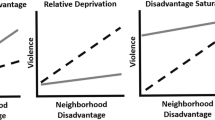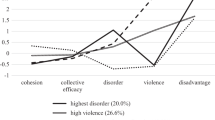Abstract
Purpose
Inconsistent evidence of a relationship between neighborhood disadvantage and adolescent mental health may be, in part, attributable to heterogeneity based on urban or rural residence. Using the largest nationally representative survey of US adolescent mental health available, we estimated the association between neighborhood disadvantage and adolescent emotional disorders and the extent to which urbanicity modified this association.
Methods
The National Comorbidity Survey Replication Adolescent Supplement (NCS-A) sampled adolescents aged 13–17 years (N = 10,123). Households were geocoded to Census tracts. Using a propensity score approach that addresses bias from non-random selection of individuals into neighborhoods, logistic regression models were used to estimate the relative odds of having a DSM-IV emotional disorder (any past-year anxiety disorder, major depressive disorder or dysthymia) comparing similar adolescents living in disadvantaged versus non-disadvantaged neighborhoods in urban center, urban fringe, and non-urban areas.
Results
The association between neighborhood disadvantage and emotional disorder was more than twice as large for adolescents living in urban centers versus non-urban areas. In urban centers, living in a disadvantaged neighborhood was associated with 59 % (95 % confidence interval 25–103) increased adjusted odds of emotional disorder.
Conclusions
Urbanicity modifies the relationship between neighborhood disadvantage and emotional disorder in adolescents. This effect modification may explain why evidence of a relationship between neighborhood disadvantage and adolescent mental health has been inconsistent. Recognizing the joint influence of neighborhood socioeconomic context and urbanicity may improve specificity in identifying relevant neighborhood processes.


Similar content being viewed by others
References
Merikangas KR, He JP, Burstein M, Swanson SA, Avenevoli S, Cui L, Benjet C, Georgiades K, Swendsen J (2010) Lifetime prevalence of mental disorders in U.S. adolescents: results from the National Comorbidity Survey Replication–Adolescent Supplement (NCS-A). J Am Acad Child Adolesc Psychiatry 49 (10):980–989. doi:10.1016/j.jaac.2010.05.017
Breslau J, Lane M, Sampson N, Kessler RC (2008) Mental disorders and subsequent educational attainment in a US national sample. J Psychiatr Res 42(9):708–716. doi:10.1016/j.jpsychires.2008.01.016
Glied S, Pine DS (2002) Consequences and correlates of adolescent depression. Arch Pediatr Adolesc Med 156(10):1009–1014. pii: poa10284
Kessler RC, Heeringa S, Lakoma MD, Petukhova M, Rupp AE, Schoenbaum M, Wang PS, Zaslavsky AM (2008) Individual and societal effects of mental disorders on earnings in the United States: results from the National Comorbidity Survey Replication. Am J Psychiatry 165(6):703–711. doi:10.1176/appi.ajp.2008.08010126
Kessler RC, Walters EE, Forthofer MS (1998) The social consequences of psychiatric disorders, III: probability of marital stability. Am J Psychiatry 155(8):1092–1096
Report of the Surgeon General’s Conference on Children’s Mental Health: A National Action Agenda (2001). Department of Health and Human Services, Washington, DC
Wikstrom PH, Sampson RJ (2003) Social mechanisms of community influences on crime and pathways in criminality. In: Lahey BB, Moffitt TE, Caspi A (eds) Causes of conduct disorder and juvenile delinquency. The Guilford Press, New York
Diez Roux AV (2004) Estimating neighborhood health effects: the challenges of causal inference in a complex world. Soc Sci Med 58(10):1953–1960. doi:10.1016/S0277-9536(03)00414-3
Gonzales NA, Coxe S, Roosa MW, White RMB, Knight GP, Zeiders KH, Saenz D (2011) Economic hardship, neighborhood context, and parenting: prospective effects on Mexican-American adolescent’s mental health. Am J Commun Psychol 47(1–2):98–113. doi:10.1007/s10464-010-9366-1
Kling JR, Liebman JB, Katz LF (2007) Experimental analysis of neighborhood effects. Econometrica 75(1):83–119
Leventhal T, Brooks-Gunn J (2003) Moving to opportunity: an experimental study of neighborhood effects on mental health. Am J Public Health 93(9):1576–1582
Simons RL, Murry V, McLoyd V, Lin KH, Cutrona C, Conger RD (2002) Discrimination, crime, ethnic identity, and parenting as correlates of depressive symptoms among African American children: a multilevel analysis. Dev Psychopathol 14(2):371–393
Xue Y, Leventhal T, Brooks-Gunn J, Earls FJ (2005) Neighborhood residence and mental health problems of 5- to 11-year-olds. Arch Gen Psychiatry 62(5):554–563. doi:10.1001/archpsyc.62.5.554
Merwin E, Snyder A, Katz E (2006) Differential access to quality rural healthcare: professional and policy challenges. Fam Community Health 29(3):186–194. pii: 00003727-200607000-00005
Galea S (2011) The urban brain: new directions in research exploring the relation between cities and mood-anxiety disorders. Depress Anxiety 28(10):857–862. doi:10.1002/da.20868
Lee AC, Maheswaran R (2011) The health benefits of urban green spaces: a review of the evidence. J Public Health (Oxf) 33(2):212–222. doi:10.1093/pubmed/fdq068
Slopen N, Fitzmaurice GM, Williams DR, Gilman SE (2012) Common patterns of violence experiences and depression and anxiety among adolescents. Soc Psychiatry Psychiatr Epidemiol 47(10):1591–1605. doi:10.1007/s00127-011-0466-5
Hernan MA, Robins JM (2006) Estimating causal effects from epidemiological data. J Epidemiol Community Health 60(7):578–586. doi:10.1136/jech.2004.029496
Kessler RC, Avenevoli S, Costello EJ, Green JG, Gruber MJ, Heeringa S, Merikangas KR, Pennell BE, Sampson NA, Zaslavsky AM (2009) Design and field procedures in the US National Comorbidity Survey Replication Adolescent Supplement (NCS-A). Int J Methods Psychiatr Res 18(2):69–83. doi:10.1002/mpr.279
Kessler RC, Avenevoli S, Green J, Gruber MJ, Guyer M, He Y, Jin R, Kaufman J, Sampson NA, Zaslavsky AM (2009) National comorbidity survey replication adolescent supplement (NCS-A): III. Concordance of DSM-IV/CIDI diagnoses with clinical reassessments. J Am Acad Child Adolesc Psychiatry 48 (4):386–399. doi:10.1097/CHI.0b013e31819a1cbc
Diez-Roux AV, Kiefe CI, Jacobs DR Jr, Haan M, Jackson SA, Nieto FJ, Paton CC, Schulz R (2001) Area characteristics and individual-level socioeconomic position indicators in three population-based epidemiologic studies. Ann Epidemiol 11(6):395–405. pii: S1047279701002216
Diez Roux AV, Borrell LN, Haan M, Jackson SA, Schultz R (2004) Neighbourhood environments and mortality in an elderly cohort: results from the cardiovascular health study. J Epidemiol Community Health 58(11):917–923. doi:10.1136/jech.2003.019596
Angold A, Weissman MM, John K, Merikangas KR, Prusoff BA, Wickramaratne P, Gammon GD, Warner V (1987) Parent and child reports of depressive symptoms in children at low and high risk of depression. J Child Psychol Psychiatry 28(6):901–915
Leventhal T, Brooks-Gunn J (2000) The neighborhoods they live in: the effects of neighborhood residence on child and adolescent outcomes. Psychol Bull 126(2):309–337
van Buuren S (2007) Multiple imputation of discrete and continuous data by fully conditional specification. Stat Methods Med Res 16(3):219–242. doi:10.1177/0962280206074463
Stuart EA, Azur M, Frangakis C, Leaf P (2009) Multiple imputation with large data sets: a case study of the Children’s Mental Health Initiative. Am J Epidemiol 169(9):1133–1139. doi:10.1093/aje/kwp026
Zanutto E (2006) A comparison of propensity score and linear regression analysis of complex survey data. J Data Sci 4:67–91
Rosenbaum PR, Rubin DB (1983) The central role of the propensity score in observational studies for causal effects. Biometrika 70(1):41–55
Rubin DB (1987) Multiple imputation for nonresponse in surveys. J. Wiley & Sons, New York
Bollen KA, Arminger G (1991) Observational residuals in factor analysis and structural equation models. Sociol Methodol 21:235–262
Peen J, Schoevers RA, Beekman AT, Dekker J (2010) The current status of urban–rural differences in psychiatric disorders. Acta Psychiatr Scand 121(2):84–93. doi:10.1111/j.1600-0447.2009.01438.x
Neckerman KM, Lovasi GS, Davies S, Purciel M, Quinn J, Feder E, Raghunath N, Wasserman B, Rundle A (2009) Disparities in urban neighborhood conditions: evidence from GIS measures and field observation in New York City. J Public Health Policy 30(Suppl 1):S264–S285. doi:10.1057/jphp.2008.47
Goodnight JA, Lahey BB, Van Hulle CA, Rodgers JL, Rathouz PJ, Waldman ID, D’Onofrio BM (2012) A quasi-experimental analysis of the influence of neighborhood disadvantage on child and adolescent conduct problems. J Abnorm Psychol 121(1):95–108. doi:10.1037/a0025078
Fagan AA, Wright EM, Pinchevsky GM (2013) Racial/ethnic differences in the relationship between neighborhood disadvantage and adlescent substance use. J Drug Issues 43(1):69–84
Vanderweele TJ, Arah OA (2011) Bias formulas for sensitivity analysis of unmeasured confounding for general outcomes, treatments, and confounders. Epidemiology 22(1):42–52. doi:10.1097/EDE.0b013e3181f74493
Krieger N, Chen JT, Waterman PD, Soobader MJ, Subramanian SV, Carson R (2002) Geocoding and monitoring of US socioeconomic inequalities in mortality and cancer incidence: does the choice of area-based measure and geographic level matter? the Public Health Disparities Geocoding Project. Am J Epidemiol 156(5):471–482
Wittchen HU (1994) Reliability and validity studies of the WHO–Composite International Diagnostic Interview (CIDI): a critical review. J Psychiatr Res 28(1):57–84. pii: 0022-3956(94)90036-1
Gelman A (2007) Struggles with survey weighting and regression modeling. Stat Sci 22(2):153–164
Faris RE, Dunham HW (1939) Mental disorders in urban areas: an ecological study of schizophrenia and other psychoses. The University of Chicago Press, Chicago/London
Dohrenwend BP, Dohrenwend BS (1974) Psychiatric disorders in urban settings. In: Caplan G (ed) American handbook of psychiatry, vol 2., Child and adolescent psychiatry. Basic Books, Inc., New York, pp 424–449
Acknowledgments
The authors wish to express their gratitude to NCS-A participants and study team who made this work possible. The authors also wish to thank Kathy Georgiades for helpful comments on a previous version of the manuscript and Vanya Aggarwal for help with Census data abstraction. Results from this paper were presented as a poster at the 45th Annual Society for Epidemiologic Research Meeting, Minneapolis, Minnesota, June 29, 2012. The Intramural Research Program of the National Institute of Mental Health at the National Institutes of Health supported this work. The National Comorbidity Survey Replication Adolescent Supplement (NCS-A) and the larger program of related National Comorbidity Surveys are supported by the National Institute of Mental Health [U01-MH60220] and the National Institute of Drug Abuse [R01 DA016558] at the National Institutes of Mental Health. The NCS-A was carried out in conjunction with the World Health Organization World Mental Health Survey Initiative. The views and opinions expressed in this article are those of the authors and should not be construed to represent the views of any of the sponsoring organizations, agencies, or US Government.
Conflict of interest
On behalf of all authors, the corresponding author states that there is no conflict of interest.
Human participant protection
The survey was administered by the professional staff of the Institute for Social Research at the University of Michigan. The recruitment and consent procedures were approved by the Human Subjects Committees of Harvard Medical School and the University of Michigan.
Author information
Authors and Affiliations
Corresponding author
Electronic supplementary material
Below is the link to the electronic supplementary material.
Rights and permissions
About this article
Cite this article
Rudolph, K.E., Stuart, E.A., Glass, T.A. et al. Neighborhood disadvantage in context: the influence of urbanicity on the association between neighborhood disadvantage and adolescent emotional disorders. Soc Psychiatry Psychiatr Epidemiol 49, 467–475 (2014). https://doi.org/10.1007/s00127-013-0725-8
Received:
Accepted:
Published:
Issue Date:
DOI: https://doi.org/10.1007/s00127-013-0725-8




